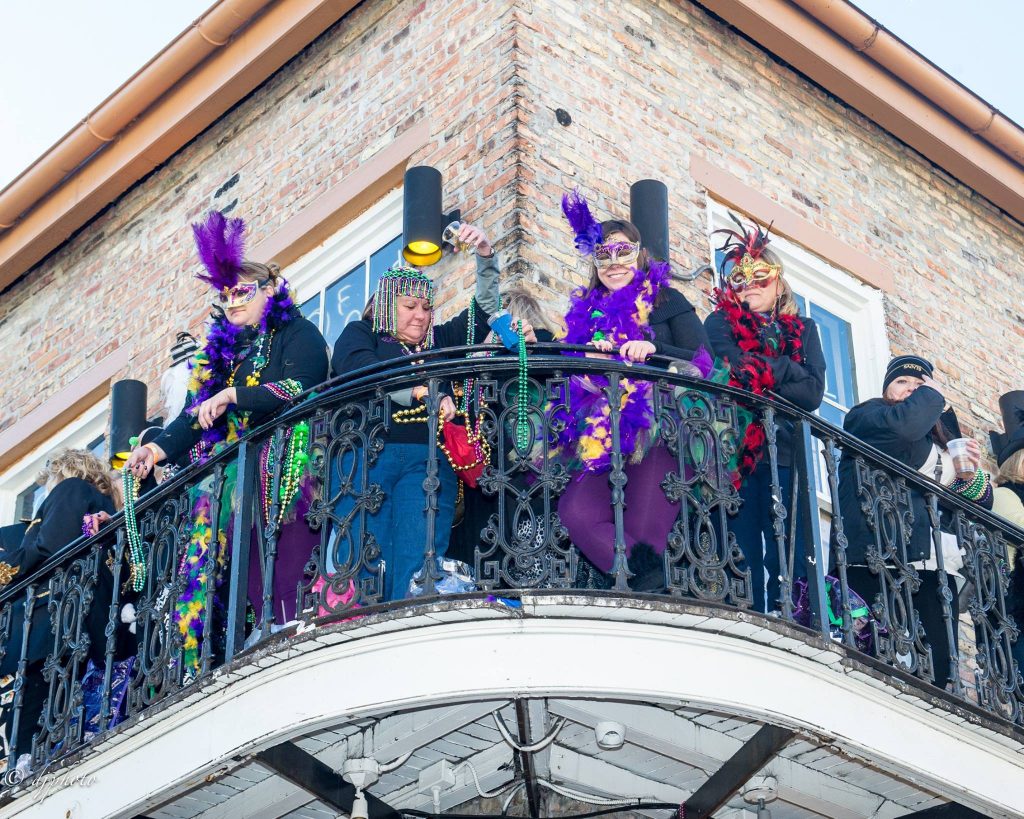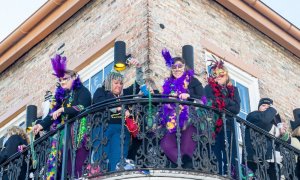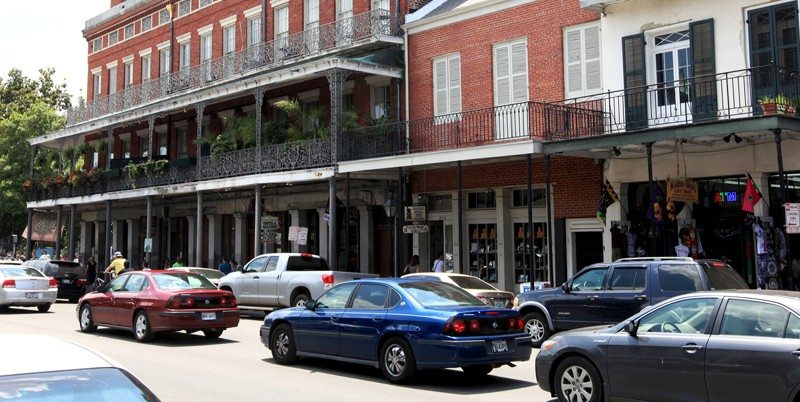All On a Mardi Gras Weekend

Photo by David Fary
This is it. The weekend when the city of New Orleans says, “Goodbye reality!” and “Hello, Mardi Gras.” This is the greatest six days of the year to be in New Orleans, hands down, and if you’re here on vacation — well, all we can say is lucky you.
The greater New Orleans area is hosting about 80 parades every year, each with its own krewe rites and related festivities. For the unfamiliar, a “krewe” is a New Orleans carnival society. Krewes can be loose affiliations of friends or massive organized entities with hierarchies and financial dues. The oldest and largest krewes in the city “roll” in parades in the weeks leading up to Mardi Gras.
Since no one can get to every activity going on the weekend preceding Fat Tuesday and leading up to Ash Wednesday (seriously, it’s not physically possible), here are some that offer the best and weirdest of Mardi Gras this parade season. Remember to pace yourself. It’s a marathon, not a sprint.
By the way, when we mention “throws” that just means something a float rider tosses to the parade audience. Throws can range from beads to toys to more individualized souvenirs. Note that all parades follow a set route; you can pick a spot anywhere along said route to watch the show, including the ticketed grandstands in the CBD and Warehouse District. For a schedule of parades, check here.
Thursday, February 27, 2025
Parades: Knights of Babylon, Knights of Chaos, Krewe of Muses (Uptown)
The Knights of Babylon go back to 1939 and honor the Carnival traditions by using the flambeaux and the floats with the same designs as decades ago. The king’s float is still drawn by a mule. Babylon’s 200 knights are led by their king, Sargon, whose identity is not revealed to the public. Babylon’s theme is also kept secret till the day of the parade.
According to Greek mythology, Chaos was the void out of which the universe and all its gods were created. In 2000, the Knights of Chaos filled the void created when the Knights of Momus stopped parading in 1992 after 100 years. The 225-member all-male krewe parades on the Thursday before Fat Tuesday (traditionally known as “Momus Thursday.”) Like Momus, Chaos presents a satirical parade. They never reveal the king’s identity or the parade theme ahead of time.
The Krewe of Muses is one of Carnival’s most popular parades thanks to its dazzling floats, top-notch marching bands, and bitingly humorous themes. The cup throw bears the design of the annual contest winner among the local school children. The winner also gets to ride as a guest of the krewe. Look for the iconic shoe float with this year’s honorary muse. And see if you can catch one of the most coveted throws of the Carnival season, the hand-decorated Muses shoe. Each shoe is a one-of-a-kind piece of art, and some parade-goers would stop at very little to score one.
Friday, February 28, 2025
Greasing of the Poles
French Quarter, 300 Bourbon Street
Every year, folks at the Royal Sonesta Hotel hold a ceremony wherein the building’s support poles are greased to keep folks from climbing onto the balcony. Hint: People still try, with hilarious results. The event is free; plan to show up early because it gets crowded.
Parades: Krewe of Bosom Buddies & Breast Friends (French Quarter), Hermes, followed by d’Etat and Morpheus (Uptown)
The Krewe of Bosom Buddies & Breast Friends is a walking krewe that parades in the French Quarter on the Friday before Mardi Gras. The parade starts and ends on Bourbon Street, and the krewe is usually dressed in tutus, bras and hats that reflect that year’s theme. The signature throw is a hand-decorated bra. The parade is raucous fun for sure, so we won’t call it 100% kid-friendly.
The Knights of Hermes has been around since the Great Depression and was one of the first parades to mobilize after Katrina. About 700 male riders are led by their captain clad in full regalia and riding a white horse.
The satirical Le Krewe d’Etat traditionally follows Hermes with 21 floats plus its Captain and officers on horseback. The theme is secret until parade day. Look for members of the krewe dressed as walking skeletons handing out the D’Etat Gazette and wooden doubloons. The Gazette has illustrations and descriptions of the floats and is only available during the parade. Another covetable throw is the blinking logo skull bead.
The Krewe of Morpheus parade is a jaw-dropping spectacle with about 500 riders and beautifully illuminated floats.
Saturday, March 1, 2025
Parades: Iris, followed by Tucks (Uptown)
Endymion (Mid-City, Downtown)
Amazingly, the Krewe of Iris has been around since 1917, making it the oldest female Carnival organization for women. Iris’ 1,500 members wear white gloves and masks, and the parade features such unique throws as king cake babies and hand-decorated sunglasses.
The Krewe of Tucks was started in 1969 by a group of Loyola students and is named after the now-gone Uptown pub. Tucks is known for satirical floats and irreverence (one of the signature floats, for example, is a giant toilet).
These days Krewe of Endymion is the only super krewe parade that graces Mid-City, and people camp out for days in advance staking their spots (heard of Krewe of Chad?). While we won’t comment on that, we certainly understand the reasons for the parade’s immense popularity. With a whopping 3,100 riders and 37 floats (many are tandem units with up to nine sections!), plus celebrity guests and big-name bands, Endymion is an amazing spectacle. It also helps that the riders are notoriously generous with beads (the krewe’s motto is “Throw ’til It Hurts”), and the event kicks off at noon with a huge block party on Orleans Avenue, Samedi Gras.
From Mid-City the parade makes its way to Lee Circle, ending up at the Champions Square and finally inside the Superdome for some serious partying at the Endymion Extravaganza.
Sunday, March 2, 2025
Parades: Okeanos, followed by Mid-City and Thoth, then Bacchus (Uptown)
Founded in 1949, the Krewe of Okeanos was originally a neighborhood parade on St. Claude Avenue but eventually moved to a traditional Uptown/Downtown route on St. Charles Avenue. Okeanos has about 250 male and female riders. Notably, instead of the traditional bal masque the krewe hosts a coronation ball where the king is presented and the queen is selected by random draw.
The Krewe of Mid-City also dates back a while, to 1933, and consists of 300 all-male members. The parade has a unique look featuring tinfoil as well as animation, and is known to rock themes irresistible to children. The king and queen are kids selected each year from the local Ronald McDonald House.
Thoth, founded in 1947, had been following its own parade route designed to pass several healthcare institutions that care for people with disabilities and illnesses (thus bringing the Carnival to those who otherwise wouldn’t be likely to see the parades rolling elsewhere). The krewe is known to throw generously and has 1,600 riders on its 50 floats. It’s one of the highlights of the Carnival.
Box of Wine is a walking parade that rolls between Thoth and Bacchus, whenever the police escort gives a green light, from a secret location that changes every year. It follows the Bacchus route but you won’t mistake it for any other Uptown parade. It is decidedly its own animal, in all its artsy, bohemian glory. Satire and the god of wine rule; and the joyful, rowdy procession of revelers clad in some of the most creative costumes you’ll see during the Carnival generously pours from boxes of wine for the onlookers lined up to see Bacchus — into cups, or straight from the box into the mouths.
The last treat of the Sunday before Mardi Gras is the unmatched super-krewe parade, Bacchus. Bacchus was the first parade to invite a celebrity king to lead the parade, breaking with the Carnival tradition. Expect spectacular animated super-floats and covetable throws. Look for the Bacchus’ signature floats like its Kong Family and the Baccha-gator. The massive parade ends at the Convention Center for its annual black-tie Rendezvous party.
Monday, March 3, 2025 (Lundi Gras)
Parades: Proteus, followed by Orpheus (Uptown)
Red Beans/Dead Beans (Marigny/Bayou St. John, Tremé)
The Krewe of Proteus is the second-oldest krewe in Carnival history, founded in 1882. Unbelievably, the floats still use the original chassis. The identity of the king of the parade is never revealed to the public. The kings traditionally ride in a giant seashell float; throws include pearl bead necklaces and plastic tridents.
Krewe of Orpheus was co-founded by musician/actor Harry Connick, Jr. and his father, Harry Connick, Sr., former New Orleans district attorney. It was the first super krewe to include both male and female riders, and it’s considered one of the most beautiful parades of the season.
The floats are elaborately designed and decorated with oversized flowers and fiber optic lighting. Covetable throws include light-up medallion beads and stuffed dragons. Like Bacchus, Orpheus ends at the Convention Center for its black-tie ball, and invites celebrities to reign as parade royalty.
A family-friendly, quirky Red Beans parade of revelers clad in costumes that are decorated with (and sometimes, made of) dried red beans started in 2008 and traditionally rolls on Lundi Gras. There’s also a slew of outfits that celebrate Louisiana folklore and food. This highly participatory walking parade of about 150 members winds from the Marigny into the Tremé, where it meets up with the newcomer Dead Beans. Formed in 2018 as a Red Beans spin-off, Dead Beans walks from the Bayou St. John neighborhood in Mid-City.
Woldenberg Park
The annual Lundi Gras Festival provides a unique glimpse at the Zulu characters that make an appearance each year at the Zulu parade on Mardi Gras Day: the Big Shot, Witch Doctor, Ambassador, Mayor, Governor, Mr. Big Stuff, and more. The free festival is hosted by the members of the Zulu Social Aid & Pleasure Club on the Riverfront and has three stages of music plus food and activities for the kids.
It’s also a Carnival tradition for Rex, the King of the Rex parade, the King of Zulu parade, and their entourage to meet on Lundi Gras on the Riverfront, and for the Mayor of New Orleans to salute the two monarchs and turn over symbolic control of the city for the following day. Don’t miss this highlight!
Tuesday, March 4, 2025 (Mardi Gras Day)
Parades: Zulu (Uptown, Tremé)
Rex, followed by Elks, and Crescent City (Uptown)
Society of St. Ann/Society of St. Cecilia (Bywater/Marigny/French Quarter)
The Krewe of Zulu parade begins bright and early on Mardi Gras Day at S. Claiborne and Jackson avenues, weaving its way down St. Charles Avenue to Lee Circle, then to Canal Street, and ending up at Broad and Orleans streets. It’s probably best to watch it towards the end of the parade, in Tremé.
Wherever you end up, however, Zulu is not to be missed. One of the oldest Carnival parades in the city, Zulu dates back to the early 1900s. Louis Armstrong reigned as its King in 1949.
Zulu’s traditional honor guard, the Soulful Warriors, has a roster of characters that make an appearance each year, including Big Shot, Witch Doctor, Ambassador, Mayor, Province Prince, Governor, and Mr. Big Stuff. One of the most covetable throws of the Carnival is Zulu’s hand-painted, glitzed-up coconut. The parade is preceded by the coronation ball, typically on the weekend before Mardi Gras, at the Convention Center.
Rex, the King of Carnival, is the mothership of many Mardi Gras traditions, like doubloon throws and even the official Carnival colors of purple, green and gold. The parade was founded in 1872, apparently to impress the visiting Grand Duke Alexei Alexandrovich of Russia.
Today the parade traditionally follows Zulu on Fat Tuesday and consists of about 600 riders. The king’s identity is kept secret until Lundi Gras, and it’s usually a civic leader and an important citizen of New Orleans. Traditionally, the city mayor hands Rex a symbolic key to the city on Lundi Gras, and Rex royalty meets the Zulu royalty.
The Krewe of Elks-Orleans, the oldest and largest of all the truck float krewes, follows Rex down St. Charles Ave with 50 individually designed truck floats carrying about 4,600 male and female riders.
The last parade of the Carnival, the Krewe of Crescent City, is also a truck parade. It follows Elks, signaling the beginning of the end of the Carnival.
If you want to see some very impressive costumes look for the Society of St Anne walking parade. The members gather in the Bywater around Piety St. and Burgundy St., and usually roll around 9 a.m. or so, through the Marigny and the Quarter to the Mississippi River, with many stops on the way. The route isn’t set in stone but you can look for them around 10 a.m. in the Marigny by the R Bar.
Since the parade’s inception in the late 1960s, the members would pay tribute to those who had passed away in the preceding year at the river, by depositing their ashes in the water, making offerings, and so on.
Along the lines of the St. Anne Society, the Society of St. Cecilia, which started marching in 2007, also walks from the Bywater around the same time to the river. The two processions inevitably merge at some point, then scatter, and are organically joined by fellow revelers. Both parades are a fabulous sight and are among some of the best things about Mardi Gras in New Orleans.
The Backstreet Cultural Museum
Mardi Gras Day morning
If you want to see Mardi Gras Indians on the march, the fantastically evocative costumes of the North Side Skull & Bones Gang, and the dazzling performances of the Baby Dolls, head to the Backstreet Cultural Museum, where all of these elements, which draw on cultural traditions that speak to New Orleans’ deep African and Native American roots, swirl into a heady brew. Trust us: It’s one of the most powerful sights you’ll see in this country at any time of the year.
The North Side Skull & Bones Gang leaves the Backstreet Cultural Museum before dawn, according to the tradition started in the 1800s, to wake up the neighborhood on Fat Tuesday. You never know when the Mardi Indians show up and where, but the Museum is a reliable spot to catch them. You can also try looking under the Claiborne Bridge and at Orleans Avenue and N. Claiborne Avenue on the earlier side of the day.
Frenchmen Street Party
All of Mardi Gras Day (till midnight for the outside activities)
The few blocks of Frenchmen Street starting at the foot of Esplanade by Decatur, and the adjacent Washington Square, are the places to be on Mardi Gras Day as the crowds merge and meander, forming a massive, all-day-long street party. It’s perfect for people-watching and showing off your own costume, running into people you know, and just dancing in the street. Come midnight, when you’ll have to clear off, there are plenty of bars along Frenchmen and nearby to duck into.
Are you coming to New Orleans for the Carnival? We’re jam-packed with parades and parties, and the temps are perfectly mild! Browse our top recommendations for historic hotels in the French Quarter at FrenchQuarter.com/hotels to find your perfect spot.
Also, check out our recommendations on How to Experience New Orleans Mardi Gras Like a Local, How to Dress for Mardi Gras, and Parade Rules and Tips.
Happy Mardi Gras!






